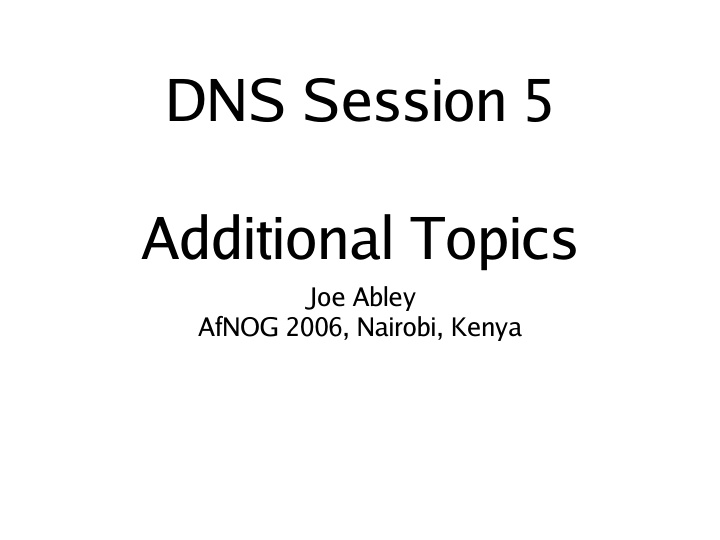



DNS Session 5 Additional Topics Joe Abley AfNOG 2006, Nairobi, Kenya
Upgrading BIND
Why Upgrade? • Almost all software has bugs • Although BIND 9 is much more conservative than previous versions, it is not immune to software defects • Better performance • New features
Where to Find BIND • http://www.isc.org/sw/bind/ • ftp://ftp.isc.org/isc/bind9/ • Today, the recommended version to run is BIND 9.3.2 • Maybe 0.01% of people have a reason to run BIND 8 instead of BIND 9 • Nobody has a reason to run BIND 4
Warning! • Many operating systems come with BIND built-in • If you compile your own, you may end up with two copies of BIND on the same server • confusing • annoying
Securing Nameservers
Host Security • Your authority servers contain valuable data • If intruders can change the records in your zones, this could spell trouble • phishing • denial-of-service • Long TTLs can make changes hard to back out (why?)
Restricting Recursion • Why control which clients can perform recursive lookups? • cache poisoning • server load • network load • reflection attacks
Separate Recursive and Authority Servers • Avoid serving stale zones authoritatively • Avoiding exposing nameservers to cache poisoning attacks is even more important when the potential client population is large, and the answers are marked authoritative
Host Local Zones Locally • Avoid leaking queries for private zones • Avoid unnecessary query loads on the root servers, or on the AS112 servers • Avoid calling ISC complaining that prisoner.iana.org is attacking you on port 53
By the Way... • Encourage people who run your network to read and understand BCP 38 • http://www.ietf.org/rfc/rfc2827.txt • Preventing source spoofing helps reduce the opportunity for many attacks, including Reflection Attacks
Restricting AXFR/IXFR • People can extract information about you and your customers by reading your zones • hosts to try and attack (e.g. ssh brute force attacks) • mail servers to exploit (e.g. relay attempts, dictionary attacks) • cache poisioning opportunities
Transaction Signatures (TSIG) • Master and slave servers: • share a common secret key • agree on the key name • have clocks which are approximately in sync (e.g. they both use NTP) (why?) • The shared information is used to authenticate a client to a server
Zone Transfers • TSIG is most-commonly used to authenticate slave servers to master servers during zone transfers • alternative to using source IP address ACLs • better than IP address ACLs (why?)
Secrets, Secrets • If you don’t run the slave servers and the mater servers yourself, you need a way to distribute the secret key to the slave server operator • how? • You also probably want to change the key every now and then (why?)
DNS Security
DNS Insecurity? • How can you trust answers you get from a cache? • How can a cache trust the answers it gets from authority servers? • How do you know that the www.centralbank.go.ke address you obtained is genuine?
DNSSEC • DNSSEC is a 10+ year effort to introduce security into the DNS • Secures the data in the DNS, not the transport • Provides a way for clients to be able to judge the security of data they extract from the DNS
General Concepts • Public Key Cryptography • Clients obtain a trusted copy of a public key used to sign the root zone • Each zone includes a signed copy of the public key of each signed daughter zone • All resource records in a signed zones are signed by a zone-signing key
Detailed Description • Ha ha, not here! • Maybe if you have a spare week!
Questions?
Recommend
More recommend